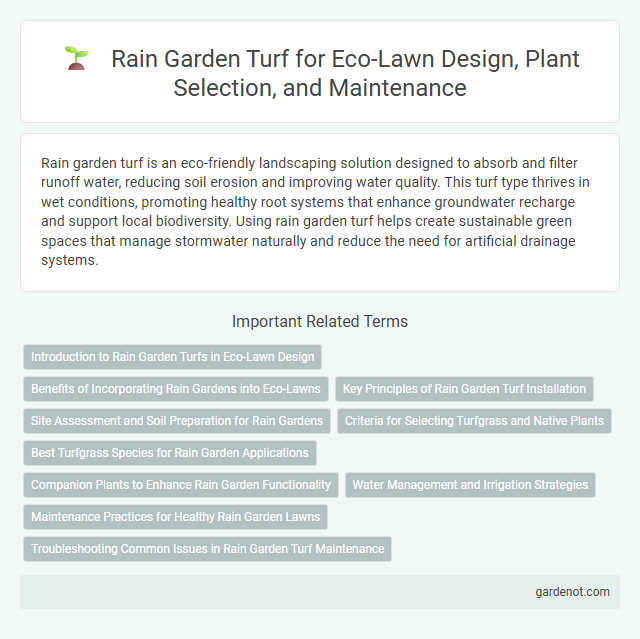Rain garden turf is an eco-friendly landscaping solution designed to absorb and filter runoff water, reducing soil erosion and improving water quality. This turf type thrives in wet conditions, promoting healthy root systems that enhance groundwater recharge and support local biodiversity. Using rain garden turf helps create sustainable green spaces that manage stormwater naturally and reduce the need for artificial drainage systems.
Introduction to Rain Garden Turfs in Eco-Lawn Design
Rain garden turf plays a vital role in eco-lawn design by enhancing stormwater management through natural filtration and absorption. These specialized grasses and ground covers are selected for their ability to thrive in moist, periodically flooded conditions while supporting biodiversity and soil health. Implementing rain garden turf effectively reduces runoff, minimizes erosion, and contributes to sustainable urban landscaping practices.
Benefits of Incorporating Rain Gardens into Eco-Lawns
Incorporating rain gardens into eco-lawns enhances water management by effectively capturing and filtering stormwater, reducing runoff and promoting groundwater recharge. These turf-integrated rain gardens support biodiversity by providing habitats for pollinators and aquatic plants, improving overall ecosystem health. Furthermore, rain garden turf boosts lawn resilience, reducing the need for chemical fertilizers and irrigation while mitigating soil erosion.
Key Principles of Rain Garden Turf Installation
Rain garden turf installation prioritizes proper soil preparation by incorporating well-draining, nutrient-rich substrates to support deep root growth and effective water infiltration. Selecting native, drought-tolerant turf species enhances resilience against fluctuating moisture levels and reduces maintenance needs. Strategic grading ensures water is directed toward the rain garden, optimizing runoff capture while preventing erosion and promoting groundwater recharge.
Site Assessment and Soil Preparation for Rain Gardens
Site assessment for rain garden turf involves evaluating soil drainage, slope, and existing vegetation to ensure optimal water absorption and plant health. Soil preparation requires amending heavy clay or sandy soils with organic matter to enhance permeability and nutrient content, creating a stable environment for turf establishment. Proper grading and erosion control measures are essential to prevent runoff and promote effective rainwater infiltration in the rain garden.
Criteria for Selecting Turfgrass and Native Plants
When selecting turfgrass and native plants for a rain garden, prioritize species with deep root systems to enhance water infiltration and soil stabilization. Choose drought-tolerant, native varieties adapted to local climate and soil conditions to minimize maintenance and chemical inputs. Optimal selections also include plants that support biodiversity by providing habitat for pollinators and beneficial insects.
Best Turfgrass Species for Rain Garden Applications
Choosing the best turfgrass species for rain garden applications involves selecting varieties that thrive in fluctuating moisture levels, such as creeping bentgrass, fine fescue, and buffalo grass. These species exhibit excellent drought tolerance and water absorption capabilities, promoting effective stormwater management and minimizing soil erosion. Incorporating deep-rooted grasses enhances soil structure and supports pollutant filtration, making them ideal for sustainable rain garden ecosystems.
Companion Plants to Enhance Rain Garden Functionality
Companion plants such as native sedges, ferns, and wildflowers improve rain garden turf by enhancing water absorption and promoting soil stability. Deep-rooted species like switchgrass and blue flag iris contribute to pollutant filtration while supporting beneficial pollinators. Incorporating diverse companion plants in rain garden turf optimizes stormwater management and ecosystem resilience.
Water Management and Irrigation Strategies
Rain garden turf enhances water management by promoting efficient stormwater absorption and reducing surface runoff, thereby mitigating flood risks and improving groundwater recharge. Strategic irrigation practices for rain garden turf prioritize using rainwater harvesting systems and drip irrigation to maintain soil moisture levels while conserving water resources. Implementing permeable soil substrates and selecting drought-tolerant turf species further optimize water retention and reduce irrigation demands.
Maintenance Practices for Healthy Rain Garden Lawns
Rain garden turf requires regular mowing at a height of 3 to 4 inches to promote deep root growth and reduce weeds. Proper watering practices include maintaining moist but not waterlogged soil, especially during establishment periods, to support drought-tolerant grass species. Incorporating organic mulch and periodic aeration enhances soil health and prevents compaction, ensuring a resilient and sustainable rain garden lawn.
Troubleshooting Common Issues in Rain Garden Turf Maintenance
Rain garden turf often faces challenges such as poor drainage, which can cause waterlogging and root rot, and inadequate sunlight leading to sparse growth. Addressing uneven soil compaction by aerating the turf and selecting drought-tolerant grass species can improve turf resilience and health. Regular inspection for pests and proper mulching helps maintain optimal moisture levels and prevents weed invasion in rain garden turf.
Rain garden turf Infographic

 gardenot.com
gardenot.com